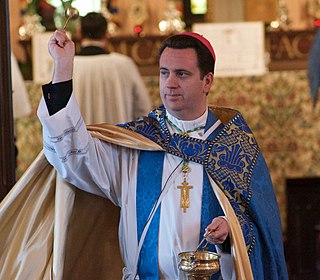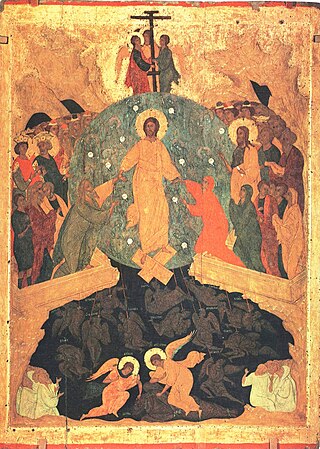
The liturgical year, also called the church year, Christian year or kalendar, consists of the cycle of liturgical seasons in Christian churches that determines when feast days, including celebrations of saints, are to be observed, and which portions of Scripture are to be read either in an annual cycle or in a cycle of several years.

The Tridentine Mass, also known as the Traditional Latin Mass or the Traditional Rite, is the liturgy in the Roman Missal of the Catholic Church codified in 1570 and published thereafter with amendments up to 1962. Celebrated almost exclusively in Ecclesiastical Latin, it was the most widely used Eucharistic liturgy in the world from its issuance in 1570 until the introduction of the Mass of Paul VI.

Liturgical colours are specific colours used for vestments and hangings within the context of Christian liturgy. The symbolism of violet, blue, white, green, red, gold, black, rose and other colours may serve to underline moods appropriate to a season of the liturgical year or may highlight a special occasion.

Holy Week is the most sacred week in the liturgical year in Christianity. For all Christian traditions, it is a moveable observance. In Eastern Christianity, which also calls it Great Week, it is the week following Great Lent and Lazarus Saturday, starting on the evening of Palm Sunday and concluding on the evening of Great Saturday. In Western Christianity, Holy Week is the sixth and last week of Lent, beginning with Palm Sunday and concluding on Holy Saturday.

Septuagesima is the name for the ninth Sunday before Easter, the third before Ash Wednesday. The term is sometimes applied to the seventy days starting on Septuagesima Sunday and ending on the Saturday after Easter. Alternatively, the term is sometimes applied also to the period sometimes called pre-Lent that begins on this day and ends on Shrove Tuesday, the day before Ash Wednesday, when Lent begins.

The Paschal Triduum or Easter Triduum, Holy Triduum, or the Three Days, is the period of three days that begins with the liturgy on the evening of Maundy Thursday, reaches its high point in the Easter Vigil, and closes with evening prayer on Easter Sunday. It is a moveable observance recalling the Passion, Crucifixion, Death, burial, and Resurrection of Jesus, as portrayed in the canonical Gospels.

Passion Sunday is the fifth Sunday in Lent, marking the beginning of Passiontide. In 1969, the Roman Catholic Church removed Passiontide from the liturgical year of the Novus Ordo, but it is still observed in the Extraordinary Form, the Personal Ordinariates, and by some Anglicans and Lutherans.

The gradual is a chant or hymn in the Mass, the liturgical celebration of the Eucharist in the Catholic Church, and among some other Christians. It gets its name from the Latin gradus because it was once chanted on the step of the ambo or altar. In the Tridentine Mass, it is sung after the reading or chanting of the epistle and before the Alleluia, or, during penitential seasons, before the tract. In the Mass of Paul VI, the gradual is usually replaced with the responsorial psalm. Although the Gradual remains an option in the Mass of Paul VI, its use is extremely rare outside monasteries. The gradual is part of the proper of the Mass.

Eastertide or Paschaltide is a festal season in the liturgical year of Christianity that focuses on celebrating the Resurrection of Jesus Christ. Preceded by Lent, it begins on Easter Sunday, which initiates Easter Week in Western Christianity, and Bright Week in Eastern Christianity.

A missal is a liturgical book containing instructions and texts necessary for the celebration of Mass throughout the liturgical year. Versions differ across liturgical tradition, period, and purpose, with some missals intended to enable a priest to celebrate Mass publicly and others for private and lay use. The texts of the most common Eucharistic liturgy in the world, the Catholic Church's Mass of Paul VI of the Roman Rite, are contained in the 1970 edition of the Roman Missal.

The Easter Vigil, also called the Paschal Vigil, the Great Vigil of Easter, or Holy Saturday in the Easter Vigil on the Holy Night of Easter is a liturgy held in traditional Christian churches as the first official celebration of the Resurrection of Jesus. Historically, it is during this liturgy that people are baptized and that adult catechumens are received into full communion with the Church. It is held in the hours of darkness between sunset on Holy Saturday and sunrise on Easter Day – most commonly in the evening of Holy Saturday or midnight – and is the first celebration of Easter, days traditionally being considered to begin at sunset.

Passiontide is a name for the last two weeks of Lent, beginning on the Fifth Sunday of Lent, long celebrated as Passion Sunday, and continuing through Lazarus Saturday. It commemorates the suffering of Christ. The second week of Passiontide is Holy Week, ending on Holy Saturday.

Asperges is the rite of sprinkling a congregation with holy water. The name comes from the first word in the 9th verse of Psalm 51 in the Latin translation which is sung during the traditional form of the rite except during Eastertide. The 51st Psalm is also one of the antiphons that may be sung in the rite under the Mass of Paul VI.

Easter Saturday, on the Christian calendar, is the seventh day of Eastertide, being the Saturday of Easter or Bright Week. In the kalendar of Western Christianity it is the last day of Easter Week, sometimes referred to as the Saturday of Easter Week or Saturday in Easter Week. It is the seventh day in the Octave of Easter too. In the liturgy of Eastern Christianity it is the last day of Bright Week, and called Bright Saturday, The Bright and Holy Septave Saturday of Easter Eve, or The Bright and Holy Septave Paschal Artos and Octoechoes Saturday of Iscariot's Byzantine Easter Eve. Easter Saturday is the day preceding the Second Sunday of Easter.

The Mass of the Lord's Supper, also known as A Service of Worship for Maundy Thursday, is a Holy Week service celebrated on the evening of Maundy Thursday. It inaugurates the Easter Triduum, and commemorates the Last Supper of Jesus with his disciples, more explicitly than other celebrations of the Mass.
The Church of the Ascension is an Anglo-Catholic parish in the Episcopal Diocese of Chicago. Founded in 1857 as a mission of St. James Church, it is now located on North La Salle Drive on Chicago's Near North Side. The church became a part of the Anglo-Catholic movement in 1869. The principal service on Sunday is the Solemn High Mass celebrated at 11 a.m., according to Rite II in the Episcopal Church's Book of Common Prayer (1979). This Mass is celebrated at the High Altar, and includes three sacred ministers, many acolytes, incense, and music provided by a professional choir. The mass includes processions and other devotions on certain feasts and holy days.
The Fifth Sunday of Easter is the fifth Sunday of the Easter season, being four weeks after the Christian celebration of Easter Sunday. In Western Christianity, this day is also known as the Fourth Sunday after Easter or Cantate Sunday. Eastern Christianity also calls this day the "Fifth Sunday," but typically using an Eastern synonym for Easter; for example, Fifth Sunday of Holy Pascha or Fifth Sunday of the Resurrection. In the Byzantine Rite, this day is also known as the Sunday of the Samaritan Woman.

A liturgical book, or service book, is a book published by the authority of a church body that contains the text and directions for the liturgy of its official religious services.
The Second Sunday of Easter is the eighth day of the Christian season of Eastertide, being the seventh after the celebration of Easter Sunday. Those churches which give special significance to this day recognize it by various names. In the Catholic Church, this day is generally known as Divine Mercy Sunday. Across Western Christianity more broadly, this day is also known as the Octave Day of Easter, White Sunday, QuasimodoSunday, Bright Sunday, and Low Sunday. In Eastern Christianity, this day is known as Antipascha, New Sunday, and Thomas Sunday.
The Fourth Sunday of Easter is the fourth Sunday of the Easter season, being the day that occurs three weeks after the Christian celebration of Easter.
















